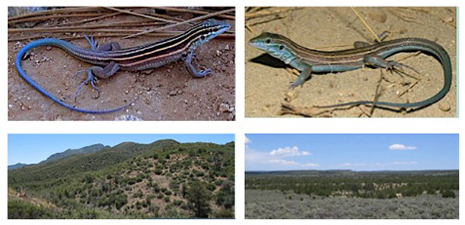
FAYETTEVILLE, Ark. — The American Society of Ichthyologists and Herpetologists awarded four University of Arkansas researchers and their collaborators Best Herpetology Paper 2014 for a paper they coauthored on the categorization of biodiversity in the journal Copeia.
Professor James M. Walker, professor Michael E. Douglas, associate professor Marlis R. Douglas and post-doctoral fellow Whitney J.B. Anthonysamy, all in the Department of Biological Sciences, together with Brian K. Sullivan and Keith O. Sullivan of Arizona State University, James E. Cordes of Louisiana State University and Mark A. Davis of the University of Illinois coauthored the paper “Conservation and Management of Polytypic Species: The Little Striped Whiptail Complex (Aspidoscelis inornata) as a Case Study.” The journal citation is: Copeia 2014:519-529.
The American Society of Ichthyologists and Herpetologists is the premier international society devoted to scientific study and conservation of fishes — ichthyology — and reptiles and amphibians — herpetology. It contributes to global efforts in biodiversity recognition and restoration, and actively promotes a new generation of scientist so as to advance the stewardship and sustainable use of resources in a rapidly changing world.
Steven J. Beaupré, chair of the Department of Biological Sciences, and Michael E. Douglas have served as presidents of the society. Copeia, the society’s journal, is internationally recognized as one of the most prestigious scientific journals of its kind and is found in over 1,000 global libraries.
Awardees will receive a commemorative plaque at the society’s 95th annual meeting July 15-19 in Reno, Nevada.
Their collaborative paper focused on the categorization of biodiversity within what is recognized as the Little Striped Whiptail complex — scientific name Aspidoscelis inornata – an assembly of small lizards found in southwestern North America. The complex is considered ‘polytypic’ because it displays a confusing mix of color and striping pattern within desert habitats. Such variation can either represent ‘true’ biodiversity, such as biologically distinct entities or species, or it could be variation within a single species.
The distinction is important. Identifying ‘true’ biodiversity helps biologists to decide where conservation efforts should be focused, and which species are truly under the threat of extinction.
The lizards do not extend across the Southwest, but are found as small groups in specific habitats. Human activities constantly alter the environment, potentially rendering it unsuitable for lizards. If a particular group of threatened lizards were from a distinct species, the threat might pose the possibility of extinction. If, however, the group shares close affiliation with individuals in other areas, the species would persist and biodiversity would be retained. Degraded habitat could be restored, and lizards from other areas could be relocated so that this particular component of the desert ecosystem would persist.
Thus, identifying ‘true’ biodiversity helps biologists to decide where conservation efforts should be focused, and which species are truly under the threat of extinction.
To solve the puzzle of the ‘polytypic’ lizards, the researchers evaluated morphological and genetic differences among individuals and groups and then applied rigorous statistical methods to re-categorize them. In tandem, these data allowed researchers to identify ‘true’ biodiversity across different categories of variables. The result? All lizards were members of the same species, albeit a variable one. This approach, in turn, has important consequences because conservation proposals were actively developed to list lizards in one area as ‘threatened’ under the Endangered Species Act.
The study is a blueprint for the categorization of global biodiversity, currently arranged as a hierarchical series of categories such as populations, subspecies, species, or genera. The manner by which a previous scientific generation partitioned variation among these categories is now often deemed ambiguous and in need of revision. The advent of modern techniques, such as the capacity to evaluate DNA variation, allows the application of much more rigor in parsing biodiversity across a larger geographic continuum.
The ambiguous categorization of biological variation is not just a problem among lizards, as dealt with in the present study, but with many other organisms as well. It unfortunately hampers contemporary conservation planning and slows the effective management of global biodiversity.
The researchers also found that some species of Whiptail Lizard exist only as females, and as such reproduce clonally. This phenomenon called ‘parthenogenesis’ is quite rare in vertebrates, and is clearly fascinating from an evolutionary perspective. Additional manuscripts on this topic are forthcoming from the U of A researchers.
About the University of Arkansas: The University of Arkansas provides an internationally competitive education for undergraduate and graduate students in more than 200 academic programs. The university contributes new knowledge, economic development, basic and applied research, and creative activity while also providing service to academic and professional disciplines. The Carnegie Foundation classifies the University of Arkansas among only 2 percent of universities in America that have the highest level of research activity. U.S. News & World Report ranks the University of Arkansas among its top American public research universities. Founded in 1871, the University of Arkansas comprises 10 colleges and schools and maintains a low student-to-faculty ratio that promotes personal attention and close mentoring.
Contacts
Marlis R. Douglas, associate professor, Department of Biological Sciences
J. William Fulbright College of Arts and Sciences
479-575-4176, mrd1@uark.edu
Amy Schlesing, Director of Science and Research Communications
University Relations
479-575-3033, amys@uark.edu